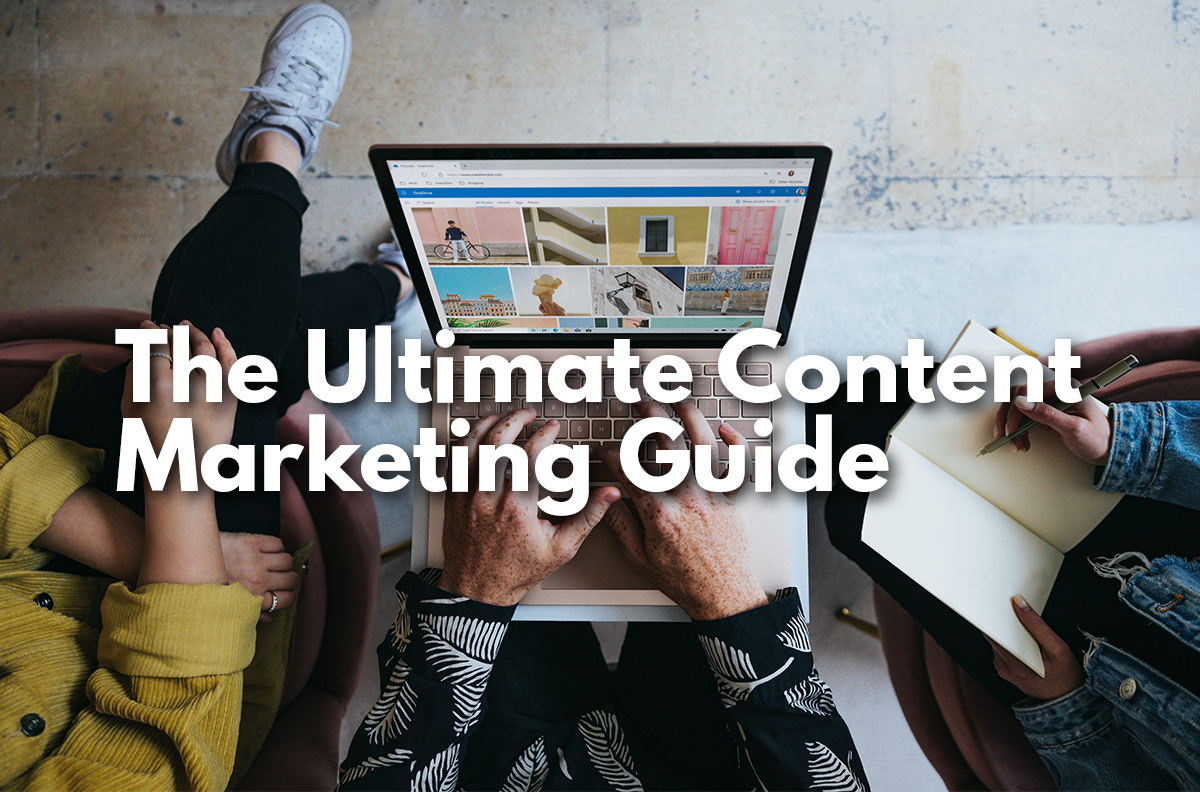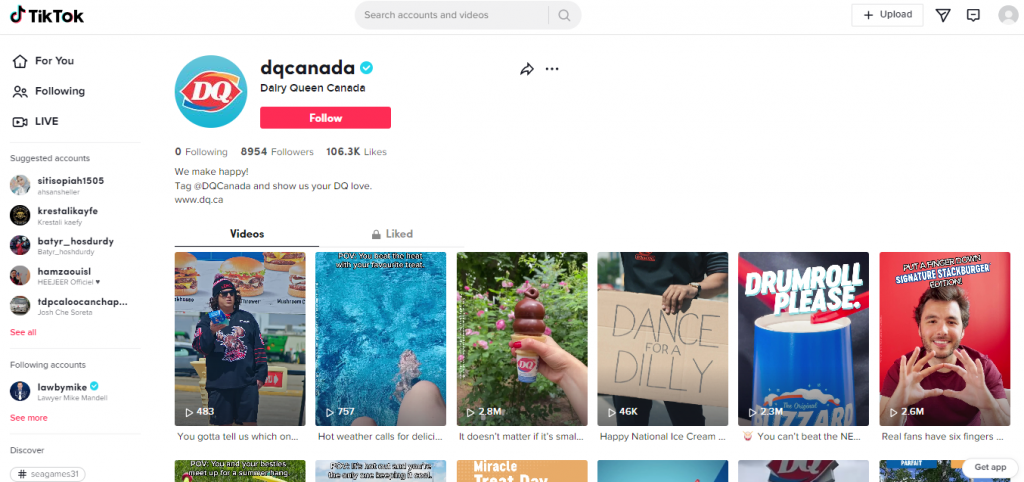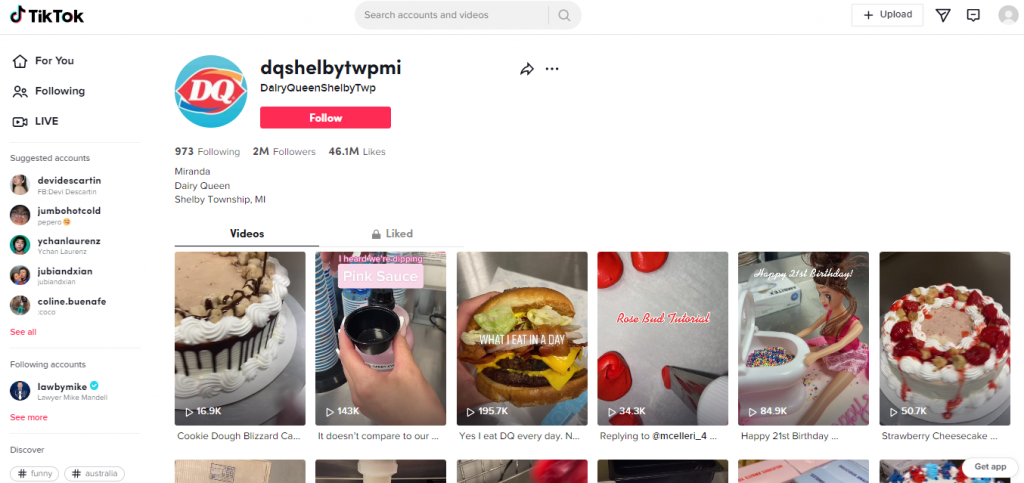Are you looking for a way to grow your business?
Content marketing is the perfect way to do just that. It helps businesses attract and retain customers by creating and sharing valuable content.
With the right strategy, content marketing can help you achieve your business goals, where you’ll be able to reach more people, convert more leads, and increase sales.
But it can be difficult to know where to start, fortunately, that’s where we come in. We’ve written the ultimate guide to content marketing to help Melbourne businesses get started on the right foot.
In this guide, you’ll find everything you need to know about content marketing, from understanding what it entails, to creating your own content marketing strategy as well as finding inspiration from other successful brands and businesses.
Keep reading to get started…
What is Content Marketing?
Content marketing is a form of marketing that businesses use to attract and retain a clearly defined audience through the creation and distribution of relevant, valuable and visual content.
This type of marketing can help your business grow by building relationships with potential and current customers, establishing trust, and positioning you as a thought leader in your industry.
Suffice to say, content marketing is not just about selling. It’s about creating interesting, informative, and valuable content that helps your target audience solve their specific problems. When done right, it can be an extremely effective way of growing your business. Hence, content marketing is one of the most important aspects of any brand you’ve encountered.
Channels for Content Marketing Besides Social Media
Social media is not the only channel for content marketing. Content can be distributed through email, newsletters, blogs, and even through traditional advertising as well as through tv ads.
By creating a variety of content and distributing it through different channels, businesses can reach a larger audience and attract more customers. But more on this later on.
How Content Marketing Helps Businesses Grow
We understand that content marketing may seem like an avenue that might not even be applicable to several businesses in Melbourne due to the nature and industry of these businesses.
However, we believe content marketing is for all types of businesses and we’ve listed a few reasons how content marketing can actually help grow any brand in Melbourne.
Helps Build Relationships With Potential and Current Customers
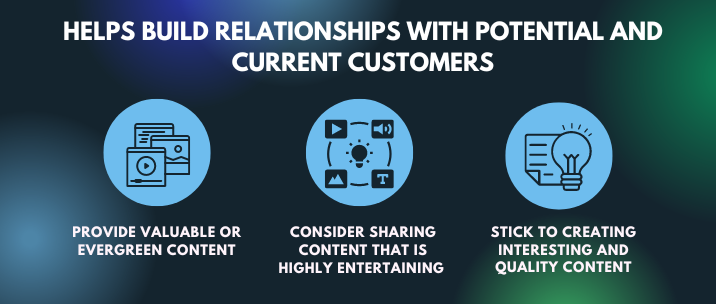
Right off the bat, content marketing can help both physical establishments and companies as well as online retailers and sellers build relationships with potential and current customers. This can be done by providing valuable or evergreen content that helps them solve a problem. In other cases, brands tend to also share highly entertaining content that makes their targeted consumers want to come back for more.
When businesses take the time to create quality content, it shows that they care about their customers and are interested in building long-term relationships with them.
Helps Increase Brand Awareness and Visibility
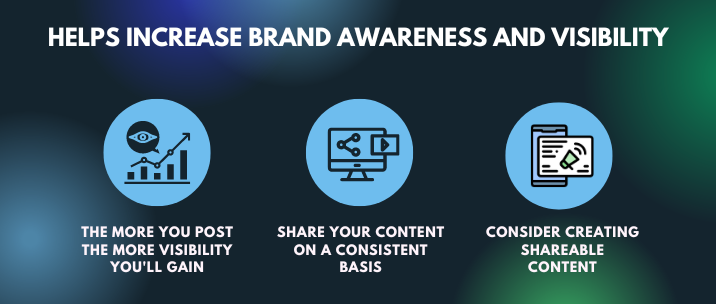
One of the most significant benefits of content marketing is that it can help in building brand awareness. Through the creation and posting of high-quality content on a consistent basis, people are more likely to understand and remember your brand, then eventually, you’ll start to see more people sharing your content with their followers. This can result in more website visits, leads, and even sales.
Helps Establish and Build Trust
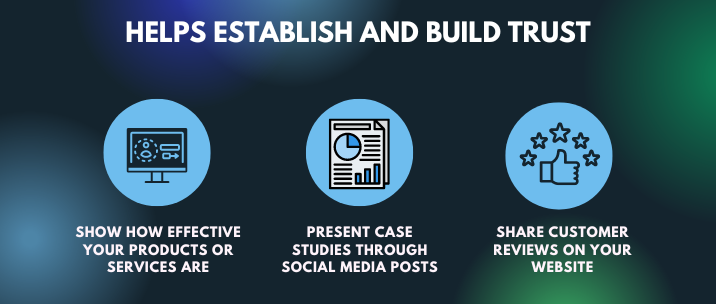
One of the ways to maximise content marketing is by using it to build trust with your customers.
But what does that look like?
By providing content that shows your target audience how effective your products or services are.
Immediately, you might think of product images as posts, but a great example would be case studies regarding your product or customer reviews that are presented as social media posts or banners on your site. This is one of the reasons why content marketing is regarded as a strategic marketing approach focused on driving results including the trust of your customers which is not always easy to secure.
It is because of this trust that can encourage customers to return, helping a business grow resulting in having a positive reputation among other competitors.
Therefore, content marketing should always be maximised to help your business or brand connect with its customers on a deeper level, as creating a connection increases the chances of repeat purchases.
Without a doubt, businesses that use content marketing as a part of their overall marketing strategy are able to grow faster than those that don’t.
Helps Generate Leads and Sales

Quality content can help businesses generate leads and sales by providing potential customers with the information they need to make a purchase decision.
What’s more is that, when businesses produce quality content on a regular basis, it often builds an audience of potential customers who are interested in what the business has to offer.
Helps Improve Search Engine Rankings
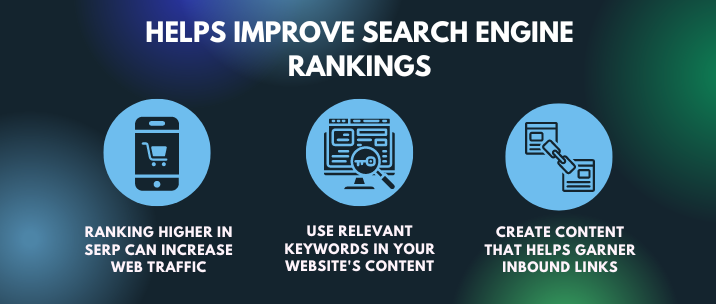
One of the key benefits of utilising content marketing is that any business or brand is able to rank higher in the search engine results pages which could, in turn, increase a business’s website traffic.
After all, if a business ranks higher on the search results pages, it becomes more likely for potential customers to find that business when they are looking for products or services related to their needs.
Through the use of relevant keywords in your website’s content, along with garnering a number of inbound links to your website, your business site becomes more relevant to your targeted set of customers.
Helps Create an Engaged Community Around the Brand
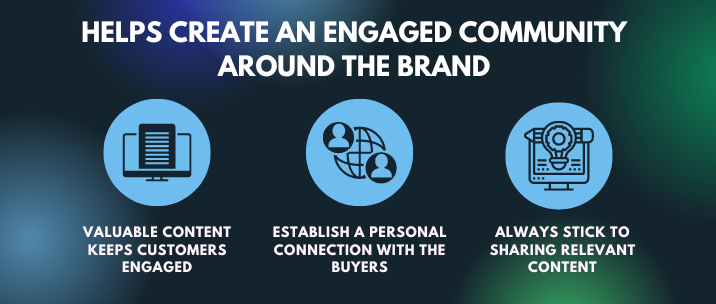
Businesses that use content marketing can see a lot of growth because they are able to create an engaged community around their brand. When customers feel like they have a personal connection to the company, they are more likely to stick around and become loyal followers.
Moreover, when customers know that a company is providing them with valuable and relevant information, they are more likely to do business with that company.
Overall, content marketing is an important part of any business growth strategy because it helps businesses attract new customers and retain existing ones. It is a cost-effective way to reach out to potential customers and promote your products or services. When done correctly, content marketing can be a powerful tool that can help you achieve your business goals.
Now that you know the benefits that content marketing has to offer your company, let’s take a look at some examples of content marketing done by various brands.
Examples of Content Marketing
In this section, we’ll be diving into several content marketing examples done right. Hopefully, these content marketing examples below will give you some inspiration and ideas for your business.
Canva’s Instagram Posts
If you haven’t seen Canva’s Instagram yet, now is the time to do so.
You will notice that Canva’s posts showcase different designs that were created by artists that you can use on their website, as well as several features that your business can use when it comes to content creation for social media posts.
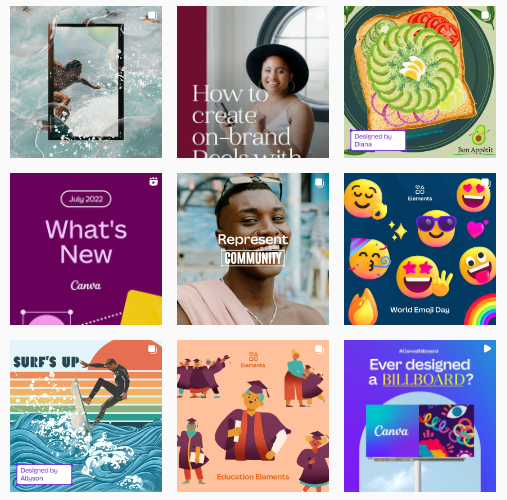
As seen above, Canva is not simply sharing colourful, high quality content, but rather, almost every post is actually useful and valuable for the viewers.
Thrive Market’s Instagram Posts
With Thrive Market, you can see they have a mix of informative posts as well as food shots for their marketing content on Instagram. This is actually a good strategy since they are selling food items and what better way to show healthy products than to present tasty dishes along with recipes as captions that include the items that they sell?
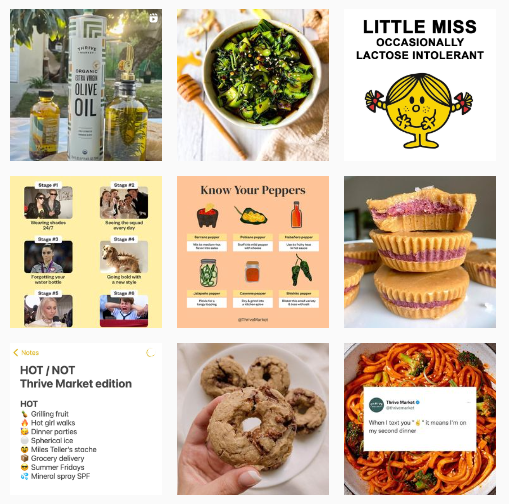
Adobe Photoshop’s User Generated Content
Adobe Photoshop’s Instagram showcases a mix of user generated content. This is absolutely fantastic if you want to promote how well your product or service works, while saving less time on content creation.
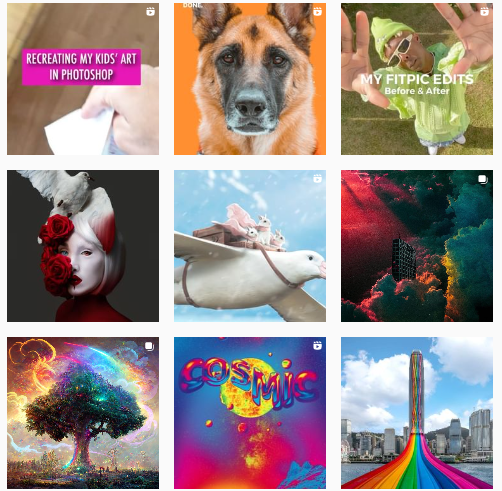
Elf Cosmetics and Their #Eyeslipsface Challenge
TikTok has been dominating other social media channels in the previous years, with brands and content creators being able to share and gain traction from their posts.
With TikTok, anyone can post either high quality video content or something a little more unedited and still achieve some optimal results, making the app one of the most valuable social media channels for most companies and brands to tap into.
One notable brand that gained a huge amount of success is e.l.f. Cosmetics. The brand created its own song and a branded hashtag challenge called #eyelipsface challenge with famous TikTok content creators joining in on the trend such as Kira Kosarin, Addison Rae, Jessica Alba, and more. And this is just one example of a brand that achieved excellent results.

Besides e.l.f. Cosmetics, there are other brands that are also on TikTok such as Dunkin Donuts, Amazon, Guess, Chipotle and more that are seeing success as well. Almost all kinds of businesses and establishments are on TikTok, from escape rooms to restaurants, candy sellers, slime shops, candle businesses and the list goes on, in hopes that their videos generate interest.
Dairy Queen’s Trendy Videos
Another business that has gained popularity is Dairy Queen with so many TikTok videos posted daily from various Dairy Queen branches.
What’s great about these videos is that, since each account is for different locations, this can help reach other users from those specific Dairy Queen branches, spreading brand awareness and increasing engagement even further.
So if you’re considering adding TikTok to be part of your content marketing efforts, we say why not give it a try! If you need help with editing your TikTok videos, download our Ultimate TikTok Video Editing Guide here.
Grammarly’s YouTube Ads
YouTube is one social media channel worth considering if you’d like to focus on video ads as part of your content marketing efforts since there are plenty of individuals that still use YouTube. Plus, you can target your ads to specific groups of people according to their interests, demographics, etc..
One of the best YouTube ads we’ve seen is Grammarly’s ads. Not only are they informative but they’re also highly engaging, using humour as a means to tell what their services are all about.
Hungry Jack’s YouTube Ads
Another example that does a great job in capturing the audience’s appetite for burgers is Hungry Jack’s. One of the fast food company’s video ads on YouTube showcases a man, eating the new Roadhouse Jack’s Fried Chicken in one clip and then the final shot focuses on the two new burgers. This helps make the viewers feel how delicious these two burgers are, persuading them to try them out.
Recipes of Woolworths
If you take a look at Woolworths’ recipes web page, you’ll find several sections such as Dinner Ideas, Budget-friendly Recipes, etc., with the categories section on the left.
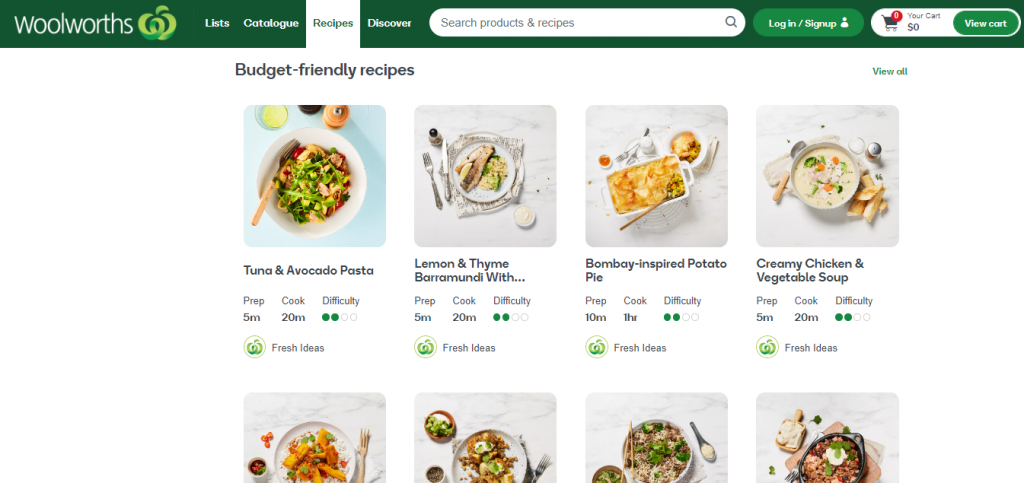
But what makes Woolworths stand out with their recipes is how easy and well-designed each recipe is, wherein the level of difficulty is shown, along with the steps on how to cook the dish separated into cards.

Harris Farm’s Guides
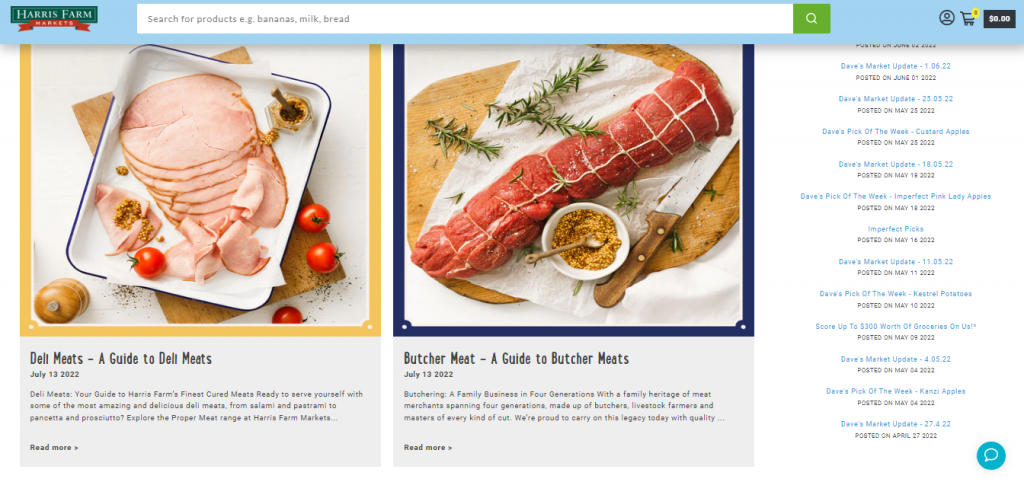
With Harris Farm’s guides, you will see various blog posts in different categories such as news, guides, pick of the week and others.
So there you have it, a few of our favourite content marketing examples. We’ll move on to what you need to know when creating your own content marketing strategy.
Creating Your Own Content Marketing Strategy
Behind every well-executed content marketing campaign is a successful content marketing strategy in place.
But how do you create one for your business?
There’s no one-size-fits-all answer to that question since each brand is different, but there are some essential elements that every winning content marketing strategy should include.
So whether you’re just starting out or you’d like your current content marketing efforts to improve, this section of the article, will walk you through the process of creating a content marketing strategy step-by-step.
By the end, you’ll have everything you need to get started on executing your very own content marketing strategy.
Establish Your Objectives and Goals

Setting objectives and goals is key when it comes to content marketing. Without a clear sense of what you’re trying to achieve, your content strategy or content marketing campaign is likely to flounder.
So, take the time to establish your goals and objectives before you begin creating content. If you have a team of content marketers in your organisation or company, we recommend sitting down with them to have a discussion on what should be done.
Make sure to discuss everything that affects your content marketing strategy, from social media marketing to paid ad content marketing initiatives, video content marketing plans, influencer marketing, the buying process, etc. This will help avoid any confusion and misalignment of efforts.
Throughout the discussion with your team, a few questions you’d want to consider (if applicable) are:
- What are you trying to achieve?
- What kind of results do you want to see?
- Will you focus on creating content for search engines?
- How many months do you want to spend when you build brand awareness?
- How will I engage my current and potential customers?
- What are the areas that I should consider in my overall digital marketing plan before setting a goal?
- What is my target when distributing valuable content?
- Is there enough time to do keyword research and set up at least one blog post?
By having a clear understanding of your goals, you can produce content that is much more likely to help you achieve them and you’ll be able to delegate the right tasks to your content marketing team or your go-to digital marketer.
Set Your KPIs

When it comes to content marketing, setting KPIs (key performance indicators) is essential in order to track and measure your success. Without KPIs, you won’t know if you’re making progress or not, and you could end up wasting time and resources on marketing content that isn’t effective.
A few of the most important KPIs to track in content marketing include:
- Number of unique visitors
- Number of leads generated
- Number of conversions
- Number of followers
- ROI (return on investment)
When you track these KPIs, you’ll be able to see which types of content are performing well and which ones aren’t. This information is essential in order to make adjustments to your content marketing strategy.
Develop Buyer Personas

All successful content marketing strategies have a buyer persona in place. If you don’t have one yet, you need to start creating buyer personas.
A buyer persona is a fictional representation of your ideal customer. It includes information such as demographics, psychographics, and buying behaviour.
Creating buyer personas will help you to understand your target audience better. This, in turn, will allow you to create content that is more relevant and engaging for them. As a result, you’ll be more likely to generate leads and conversions for your content marketing campaigns.
Ahrefs actually discusses the steps for creating your very own buyer personas, simply click here to learn all about it.
Decide on Content Formats

There are many different content formats that can be used for content marketing. Some of the most popular formats include blog posts, infographics, videos, and social posts.
But you’ll need to be careful with the content format you choose as you’ll want it to be in line with your overall digital marketing plan.
Blog Posts
Blog posts are one of the most popular content formats for content marketing. They are a great way to share your knowledge and expertise with your audience and can help to build trust and credibility.
One of the best blog posts that provide great expertise on all things SEO is Ahrefs. You can take a look at their blogs to find out more.

Here are a few tips when you start creating your very first blog post for your business:
- Come up with content ideas that people will want to read
- Promote your blogs on social media
- Consider how often you should be publishing new content for the best results
- Make sure each blog post is both SEO and user friendly to increase the chances of ranking higher in search engines’ results page
- Create shareable content that will get your readers talking
Infographics
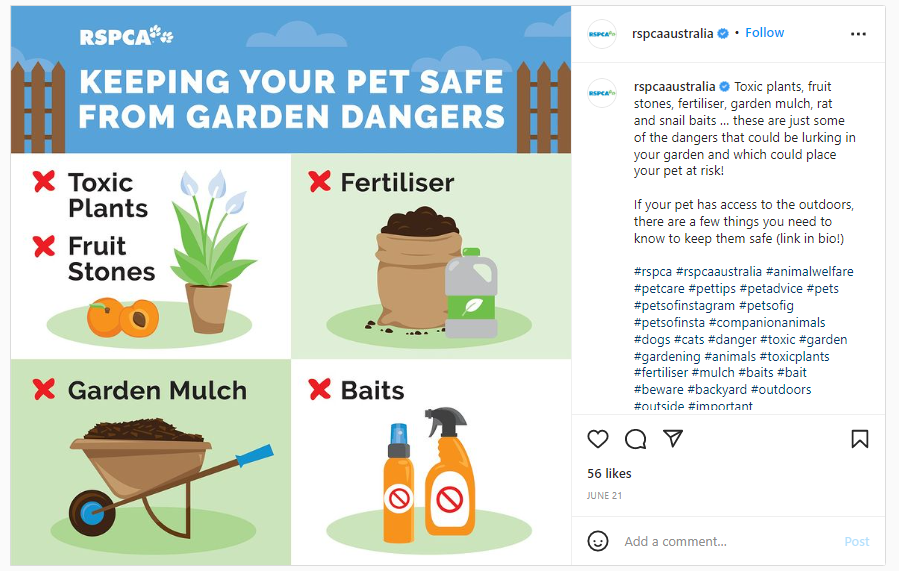
Infographics are a creative way to share information in a visually appealing format. They can easily grab the attention of your target audience and can be used to drive traffic to your website or blog for your readers to know more.
RSPCA Australia’s infographic above is simple but straightforward when it comes to informing its audience on how to keep your pets safe from garden dangers.
To create your own infographics, follow our 5 step process below:
1. Select the Right Topic
When you’re creating an infographic, it’s important to choose a topic that’s both interesting and relevant to your audience. If you select the wrong topic, your infographic may not be as successful as you’d hoped.
Your infographic’s topic should be something that people will actually want to read about. Apart from being interesting, it should be informative without being too technical or dry.
2. Create a Storyboard
A storyboard can help you plan out the story you want to tell by laying out each individual image, giving you some insight into how these images will fit into the overall narrative.
3. Gather Data and Statistics
One of the most important things to keep in mind when creating an infographic is to make sure your data is accurate and supports your story. When gathering data, be sure to use reputable sources.
Once you have your data, it’s time to start designing your infographic.
4. Design Your Infographic
As you design your infographic, make sure to stick to your brand or company’s overall look and feel. At the same time, you want your infographic to be visually appealing and easy to read.
Some other things to consider when designing your infographic are:
- The colour palette you will use (will you stick to bright, eye-catching colours or mix your brand colours?)
- The fonts that will serve as the headline and sub-text
- Your chosen layout (a square or rectangle)
- The inclusion of charts, graphs and numerical figures
- Short, easy-to-read sentences
5. Promote Your Infographic
Once your infographic is complete, you’ll want to promote it to get the most exposure. You can share it on your website, blog, and social media pages.
Videos
Videos are considered to be a highly immersive means to share your message with your audience as they can easily engage your viewers and help to build credibility within minutes. This is especially true if your product needs to be demonstrated in order to showcase its effectiveness and use.

Take a look at Go Pro’s YouTube channel, where you’ll mostly see thrilling adventure videos that the Go Pro has captured, allowing the audience to understand how well the Go Pro performs under various conditions such as rain, ocean diving, biking through forests and so on.
Your business could even use YouTube Shorts to make fun and engaging short videos similar to TikTok videos.
Sideserf Cake Studio posts fantastic content that shows her making hyper-realistic cakes while doing a voice-over on these videos. Several of her videos have a unique twist such as the “Let’s Play REAL or CAKE?” video content, where she asks her audience whether what she made was a cake, or if what was presented was a real item.
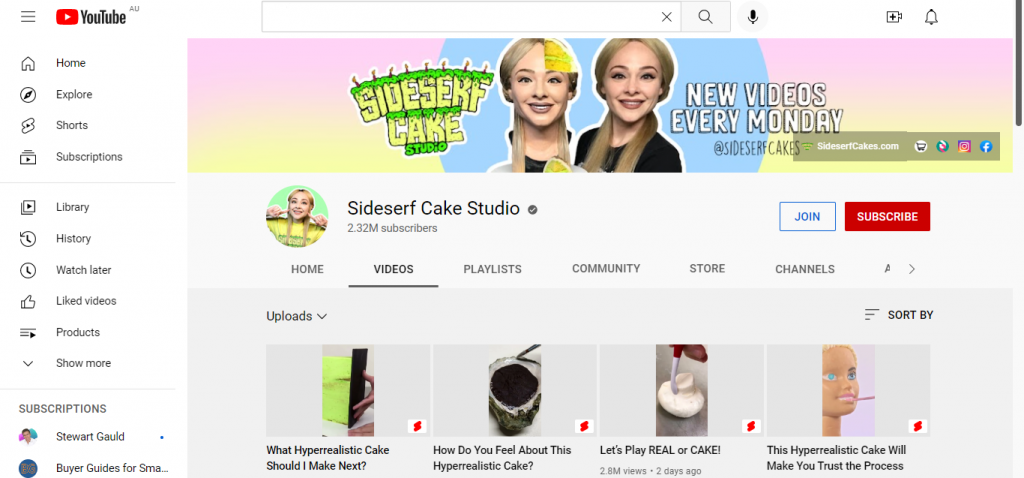
If you’d like to get started on YouTube Shorts, here are our top 5 tips to help you with your video content:
1. Keep It Short
Most people have a shorter attention span than ever, so keep your videos short and sweet – around fifteen to one minute long.
2. Be Interesting
No one wants to watch a boring video, so make sure your content is interesting and engaging.
3. Be Creative
Be creative in both the visuals and the narrative of your video to make it truly stand out.
4. Call-to-action
Include a call to action at the end of your video to encourage viewers to take your desired action.
Use relevant hashtags in your video description to help people find your content.
Social Media Posts
With social media posts, there is more flexibility when it comes to the content you share online, especially when it comes to posts that are meant to engage with your followers and other interested individuals.
Additionally, with social media, you have the freedom to style your feed with one cohesive look or template and be as creative as you want when it comes to how it will appear.
Take a look at Wix’s Instagram profile. It’s colourful and has various kinds of posts from informative ones to artistic ones.

Whitepapers
A whitepaper is a document that is used to promote or market a particular product or service and is usually long and detailed, as it provides key information about what is being promoted.
Whitepapers are often used by businesses to educate potential customers about the benefits of their products or services. To give you an idea of what whitepapers are, Ethereum, the well-known blockchain, provides us with some insight into their whitepaper which you can view by clicking here.

Whitepapers can be very effective because they are often seen as more credible than other forms of marketing material. This is because whitepapers are usually written by experts in the field, and they provide detailed information about the topic at hand. Whitepapers can also be very helpful in boosting a company’s search engine optimisation (SEO) efforts, as they can be packed with keyword-rich content.
If you are thinking about using whitepapers to promote your business, there are a few things you should keep in mind.
Make sure that the whitepaper is well-written and informative. It should be free of errors, and it should be able to hold the attention of the reader from start to finish. Prior to publishing, check if your whitepaper is properly formatted and easy to read. Lastly, your whitepaper should have credible information.
Podcasts
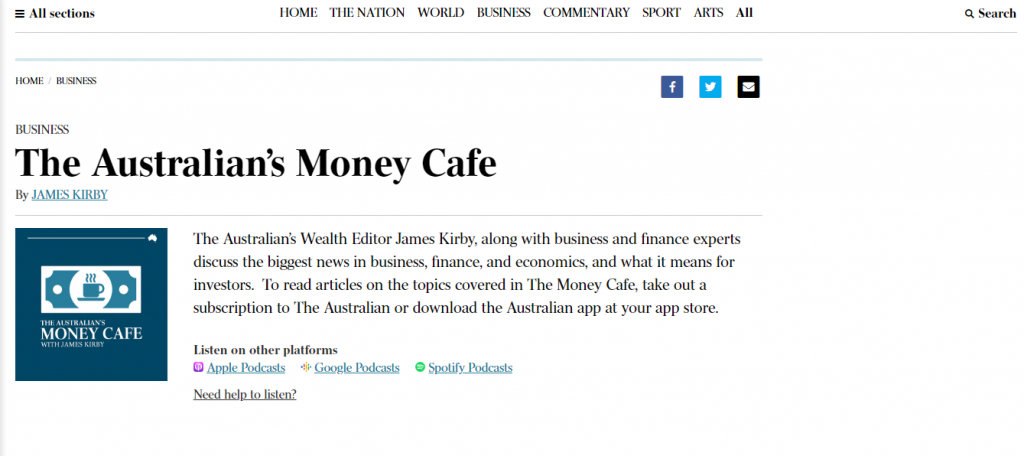
Podcasts are one of the highly effective ways to share your knowledge, expertise and advice with your audience. You’ll be able to build solid trust and credibility as you get to take the time to expound on things further, especially if you invite a speaker who is an expert on the topic being discussed.
Ultimately the goal is to produce a high-quality and informative show that keeps listeners coming back for more.
To make sure that your podcast is a success, it should be properly outlined and easy to listen to. You’ll also need to consider setting up a professional recording area to record your podcast, as this will give it a more polished sound.
Take a look at these companies and organisations that are doing podcasts to help you have an idea of how to create yours:
If you’re looking for a way to take your efforts to the next level, consider using podcasts as part of your content marketing strategy.
Paid Advertisements
From carousel ads to video advertisements, paid ads should still be an option when you create your content marketing strategy.
But why?
Simply because paid advertisements can be another avenue to reach your audience in a more targeted way. They help get your message out there, especially if the industry of your business easily saturates social media. Furthermore, they can help to boost your sales and grow your business through retargeting ads.
Take a look at Sneaker District’s paid ad content marketing tactic below, an example mentioned in HootSuite’s Instagram Ads article. It’s a simple carousel ad on Instagram that shows the different sneakers that the business sells. It’s simple and easy to understand as well as engaging enough for sneakerheads to click on.

With paid advertising, there are a few key considerations that you’ll always need to keep in mind whether you’re sharing video content or still images:
- Know your audience
- Research your competition
- Set a budget and be prepared to adjust it
- Create powerful ads with a strong message
- Test, test, test
If you’ve decided to include paid ads in your content marketing strategy, make sure to download our TikTok Ads Guide or Google Ads Guide here and here.
Webinars
Webinars are a valuable part of any content marketing strategy. By hosting a webinar, you can reach a large audience with your message and help establish relationships with potential customers.
When planning a webinar, be sure to consider your goals and target audience. What do you want to achieve with the webinar? Who are the individuals that you want to reach?
Your webinar should be planned and structured like any other piece of content you create. That means having a clear objective, identifying your target audience, and creating interesting and informative content that will engage your audience.
Oreana Financial Services offers webinars and recordings of previous webinars which are valuable resources for those who would like to learn things all about money and finance.

The format of your webinar will also play a role in its success.
Do you want to go for a more traditional lecture-style format? Or do something a little more interactive where users can join in the video and ask a question during the live session.
Once you have a plan in place, it’s time to promote your webinar. Use all of your marketing channels to get the word out, including social media, email, and paid advertising.
Lead Magnets
Lead magnets are a valuable part of content marketing.
They’re offers or incentives that you give away in exchange for someone’s contact information, such as an email address. This can be a valuable way to grow your email list and build long-term relationships with your audience.
There are a lot of different types of lead magnets you can create, but some popular examples include ebooks, checklists, and templates. If you’re not sure what would be most valuable to your audience, consider surveying them to find out.
This lead magnet from Homing Instincts is in the form of a discount offer and even mentions that the brand won’t be spammy, ensuring its customers that they will only send valuable emails.
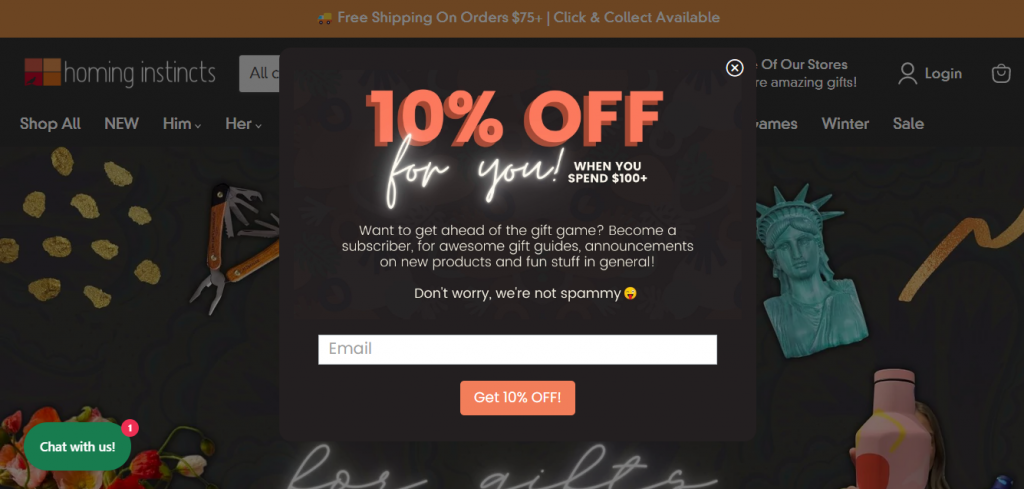
If you’d like to improve on the types of emails your company sends, Content Marketing Institute has an article on email marketing that can help you, simply click here to learn more.
Keep in mind that lead magnets should be relevant to your target audience. Otherwise, you’ll just end up with a list of uninterested people who are unlikely to buy from you.
Follow the steps below to get started on creating your lead magnet:
1. Decide What You Want to Offer as a Lead Magnet
It could be an e-book, a guide, a video tutorial, or even a free consultation.
2. Create a Landing Page for Your Lead Magnet
This is where you will drive traffic in order to get people to sign up for your free offer.
Landing pages should be designed with a specific goal in mind. That goal might be to get a visitor to sign up for a mailing list, download a whitepaper, or make a purchase. Whatever the goal may be, it’s important to make sure that the page is easy to navigate and that the call to action is clear. You don’t want to give your visitors too much information or distract them with too many links. Keep it simple and focused on the goal at hand.
3. Promote Your Lead Magnet
Use social media, email marketing, or even paid advertising to get the word out about your free offer.
4. Collect Leads
Once people have signed up for your lead magnet, you can then start marketing to them and selling your products or services. But remember, it’s important not to bombard your subscribers with emails, otherwise they’ll opt to unsubscribe from your list.
By following these steps, you can create your own lead magnets that will help you grow your business. If you need help creating a landing page or promoting your lead magnet, contact us today!
Establish Your Buyer’s Journey
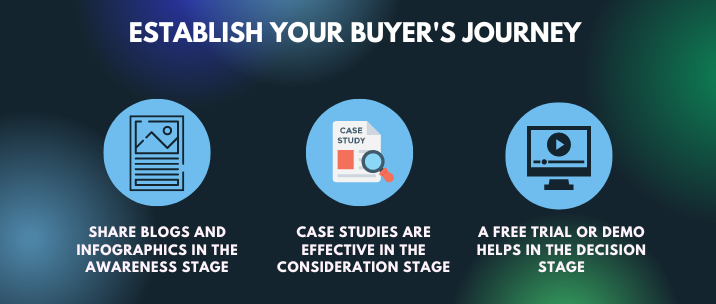
When it comes to content marketing, it’s important to consider the buyer’s journey (content marketers know how important this is!).
Your buyer’s journey is what will help your content marketing strategy achieve or drive profitable customer action. This is the path that a potential customer takes from recognising a need or problem to buying a product or service to solve that need or problem.
There are three stages in the buyer’s journey: awareness, consideration, and decision.
In the awareness stage, the buyer is just becoming aware of the problem they have. They’re starting to do some research and are looking for information about potential solutions.
In the consideration stage, the buyer is narrowing down their options and compares different solutions.
And in the decision stage, the buyer is ready to make a purchase.
Content marketing can help at all stages of the buyer’s journey. For example, in the awareness stage, content such as blogs and infographics can help educate the buyer about the problem they’re facing.
In the consideration stage, a case study, for instance, can help the buyer compare different options and make a decision. And in the decision stage, a free trial or demo can help persuade the buyer to choose your product or service.
Creating the ideal content along with the appropriate marketing messages that resonate with your buyers isn’t easy. But thoroughly understanding your buyers and knowing what stage of the journey a potential customer is in, can help you create great messaging and impactful visual content that is relevant and more likely to convert.
Moreover, it will help you create consistent content that your customers can expect from you which can help you attract more customers and grow your business.
Select the Channels for Content Marketing
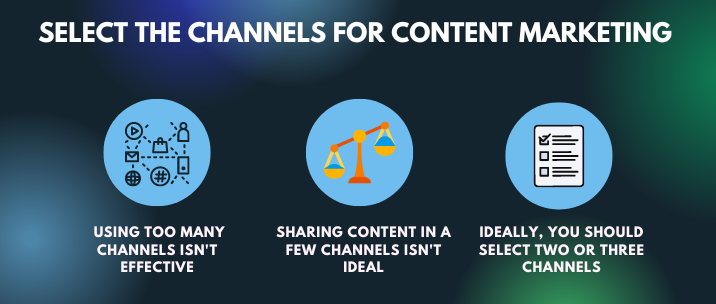
Selecting the right channels is essential for success. If you try to use too many channels where your customers aren’t in, you’ll just waste time, resources and effort. If you use too few, you won’t reach enough of your target audience.
Ideally, you should select two or three channels that are most likely to reach your target audience. Then, you can create a content calendar that outlines what you’ll post on each channel and when.
Furthermore, the content you publish should always be suited for consumption on the chosen platform. For instance, visual content is better viewed on social media platforms such as Instagram or Pinterest.
To help you select the right channels, here are a few tips:
Do Your Research
Look at your target audience and figure out where they spend their time online. Determine what social media platforms they use and what type of content they consume and mostly engage with.
Once you have a good understanding of your audience, you can start to narrow down your channel options.
Consider Your Goals
What are you trying to achieve with your content marketing tactics? Are you looking to generate leads? Drive traffic to your website? Increase brand awareness?
Remember, your content marketing strategy won’t be effective if you distribute your content in too many channels that aren’t even where your customers are.
Once you know your goals, you can start to identify which channels will be most effective in helping you reach them.
Consider Your Budget
Not all channels are created equal when it comes to cost. Some, like social media, are relatively inexpensive, while others, like pay-per-click platforms, can be more expensive. Therefore, it’s important to consider your budget when selecting your content marketing channels. You don’t want to end up over-compromising for the wrong things.
Test and Measure
Once you’ve selected a few potential channels, it’s important to test them out to see what works best for your business. Try different approaches and see which ones generate the most engagement from your target audience. Then, you can start to focus your content efforts on the channels that are most effective for your business.
Set and Implement a Budget
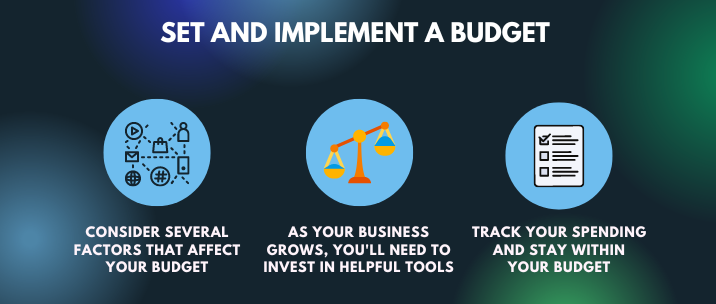
Your content marketing strategy is only as effective as the budget you allot. Understandably, there are many content marketing tactics that do not cost at all, but as your business grows, you’ll need to invest in content marketing tools that will help you grow and thrive even further.
And so, without a budget, you’ll likely end up spending more than you can afford and you may not see the results you’re looking for.
When setting your budget, it’s important to consider the following:
- The type of relevant content you want to create
- The amount of content you want to create
- The channels you want to use to distribute your content
Once you’ve considered these factors, you can start to set a budget. It’s important to track your spending and make sure you’re staying within your budget.
Analyse and Measure Results
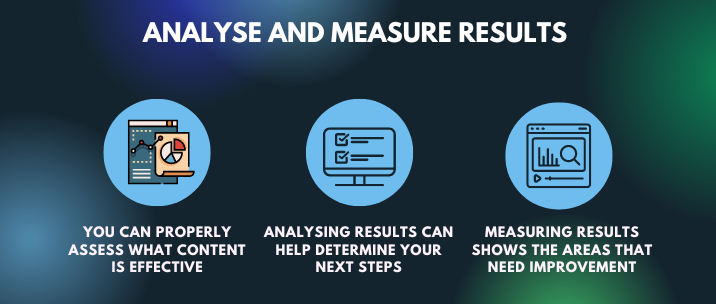
Analysing and measuring results is essential in order to determine whether or not your efforts are paying off. By taking the time to analyse data such as website traffic, social media engagement, and leads generated, you can effectively assess what content is resonating with your audience and generate better results moving forward.
Overall, analysing and measuring results is crucial for any business that wants to utilise content marketing as a way to grow their audience and drive conversions. Without this data, it would be impossible to determine which content marketing strategies are working and which ones need to be tweaked or abandoned altogether.
Additional Tips
Always Be Prepared to Adjust Your Plan as Needed
No matter what your goals are, it’s always important to be prepared to adjust your plan as needed. The content marketing world is constantly changing, the same goes for industry trends. What works today may not work tomorrow. So, it’s important to be flexible and willing to make changes as needed.
If you’re not seeing the results you want, don’t be afraid to experiment with different content types or change up your distribution channels. By staying flexible and adaptable, you’ll be in a better position to succeed in the long run.
Use Content Marketing Tools
Businesses and brands use a variety of content marketing tools to create and distribute content that will better help them achieve their content marketing objectives.
Some of the most popular tools that content marketers suggest include:
- Google Analytics
- Grammarly
- Ahrefs
- SEMRush
- MailChimp
- Buffer
- Zapier
- WordPress
- Canva
- ClickFunnels
- HootSuite
Try Different Content Formats
With content marketing, it’s important to try different content formats to see what works best for you and your audience. By doing so, you can identify which formats are most effective at engaging your audience and driving conversions.
Ultimately, businesses should always be willing to experiment with new content formats if they want to see the best results from their content marketing campaigns.
Be Consistent With Your Publishing Schedule
One of the most important things to remember with your content marketing strategy is to be consistent with your publishing schedule. By publishing content on a regular basis, you’ll be able to keep your audience engaged and help them stay up-to-date on your latest offerings.
Additionally, being consistent with your publishing schedule will help you to build some hype with your audience. They’ll know that they can rely on you to provide them with quality content on a regular basis.
If you’re not sure how often you should be publishing content, start by experimenting and see what works best for you and your audience. Once you’ve found a schedule that works, stick to it as much as possible.
Don’t forget that the goal is to create valuable, relevant content that will help you achieve your business goals. If you keep this in mind, you’ll be on your way to success.
Keep an Eye on the Competition
As a business owner, it’s important to keep an eye on your competition and learn from their successes and failures. You’ll be able to stay ahead of the curve and continue to see results.
One way to learn from your competition is to look at what’s working well for them and try to implement similar tactics in your own content marketing efforts.
Don’t be afraid to try new things and take risks. Sometimes, the best way to learn is through trial and error.
Conclusion
Overall, content marketing can be a great way to grow your business, but it is important to remember that it takes time and effort to build up a community of engaged customers. If you are patient and consistent with your content marketing strategy, you will eventually see the results you are looking for.
Want to get started on content marketing but need some help?

